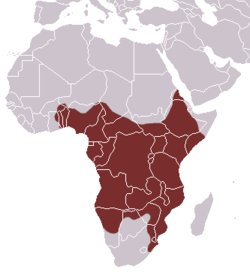| Rusty-spotted genet | |
|---|---|
 | |
| Scientific classification | |
| Kingdom: | Animalia |
| Phylum: | Chordata |
| Class: | Mammalia |
| Order: | Carnivora |
| Family: | Viverridae |
| Genus: | Genetta |
| Species: | G. maculata |
| Binomial name | |
| Genetta maculata (Gray, 1830) | |
 | |
| Rusty-spotted genet range | |
The rusty-spotted genet (Genetta maculata), [2] also called panther genet and large-spotted genet, is a genet that is widely distributed in sub-Saharan Africa. It is considered common and therefore listed as Least Concern on the IUCN Red List. [1]
